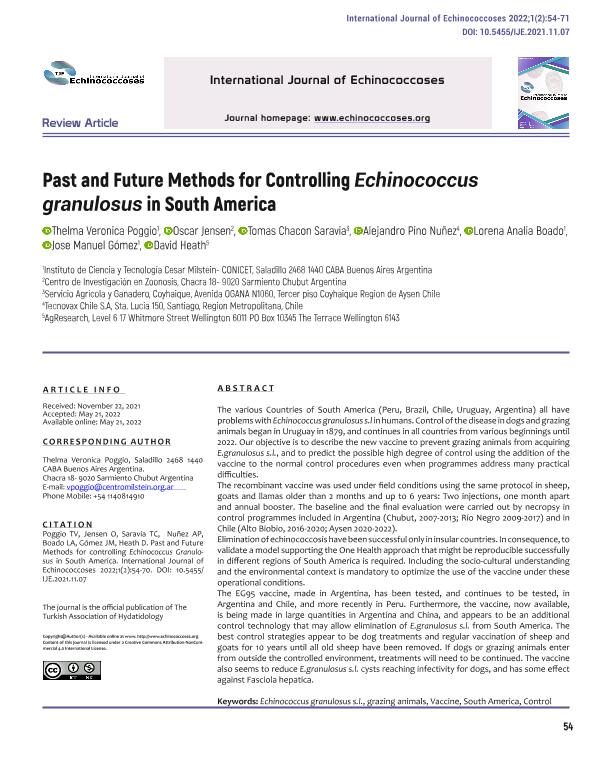Mostrar el registro sencillo del ítem
dc.contributor.author
Poggio, Thelma Veronica

dc.contributor.author
Jensen, Oscar

dc.contributor.author
Chacon Saravia, Tomas
dc.contributor.author
Pino Nuñez, Alejandro
dc.contributor.author
Boado, Lorena Analía

dc.contributor.author
Gomez, Jose Manuel

dc.contributor.author
Heath, David
dc.date.available
2023-08-18T14:48:17Z
dc.date.issued
2022-05
dc.identifier.citation
Poggio, Thelma Veronica; Jensen, Oscar; Chacon Saravia, Tomas; Pino Nuñez, Alejandro; Boado, Lorena Analía; et al.; Past and Future Methods for Controlling Echinococcus Granulosus in South America; The Turkish Association of Hydatidology; International Journal of Echinococcoses; 1; 2; 5-2022; 26-71
dc.identifier.issn
2822-3152
dc.identifier.uri
http://hdl.handle.net/11336/208728
dc.description.abstract
The various Countries of South America (Peru, Brazil, Chile, Uruguay, Argentina) all haveproblems with Echinococcus granulosus s.l in humans. Control of the disease in dogs and grazinganimals began in Uruguay in 1879, and continues in all countries from various beginnings until2022. Our objective is to describe the new vaccine to prevent grazing animals from acquiringE.granulosus s.l., and to predict the possible high degree of control using the addition of thevaccine to the normal control procedures even when programmes address many practicaldifficulties.The recombinant vaccine was used under field conditions using the same protocol in sheep,goats and llamas older than 2 months and up to 6 years: Two injections, one month apartand annual booster. The baseline and the final evaluation were carried out by necropsy incontrol programmes included in Argentina (Chubut, 2007-2013; Río Negro 2009-2017) and inChile (Alto Biobio, 2016-2020; Aysen 2020-2022).Elimination of echinococcosis have been successful only in insular countries. In consequence, tovalidate a model supporting the One Health approach that might be reproducible successfullyin different regions of South America is required. Including the socio-cultural understandingand the environmental context is mandatory to optimize the use of the vaccine under theseoperational conditions.The EG95 vaccine, made in Argentina, has been tested, and continues to be tested, inArgentina and Chile, and more recently in Peru. Furthermore, the vaccine, now available,is being made in large quantities in Argentina and China, and appears to be an additionalcontrol technology that may allow elimination of E.granulosus s.l. from South America. Thebest control strategies appear to be dog treatments and regular vaccination of sheep andgoats for 10 years until all old sheep have been removed. If dogs or grazing animals enterfrom outside the controlled environment, treatments will need to be continued. The vaccinealso seems to reduce E.granulosus s.l. cysts reaching infectivity for dogs, and has some effectagainst Fasciola hepatica.
dc.format
application/pdf
dc.language.iso
eng
dc.publisher
The Turkish Association of Hydatidology
dc.rights
info:eu-repo/semantics/openAccess
dc.rights.uri
https://creativecommons.org/licenses/by-nc-sa/2.5/ar/
dc.subject
ECHINOCOCCUS GRANULOSUS
dc.subject
PROGRAMAS DE CONTROL
dc.subject
VACUNA EG95
dc.subject
OVINOS CAPRINOS
dc.subject.classification
Otras Ciencias Veterinarias

dc.subject.classification
Ciencias Veterinarias

dc.subject.classification
CIENCIAS AGRÍCOLAS

dc.title
Past and Future Methods for Controlling Echinococcus Granulosus in South America
dc.type
info:eu-repo/semantics/article
dc.type
info:ar-repo/semantics/artículo
dc.type
info:eu-repo/semantics/publishedVersion
dc.date.updated
2023-06-23T17:23:15Z
dc.journal.volume
1
dc.journal.number
2
dc.journal.pagination
26-71
dc.journal.pais
Turquía

dc.journal.ciudad
Karsiyaka Izmir
dc.description.fil
Fil: Poggio, Thelma Veronica. Consejo Nacional de Investigaciones Científicas y Técnicas. Oficina de Coordinación Administrativa Parque Centenario. Instituto de Ciencia y Tecnología "Dr. César Milstein". Fundación Pablo Cassará. Instituto de Ciencia y Tecnología "Dr. César Milstein"; Argentina
dc.description.fil
Fil: Jensen, Oscar. Centro de Investigacion En Zoonosis; Argentina
dc.description.fil
Fil: Chacon Saravia, Tomas. Ministerio de Agricultura, Ganadería, Pesca y Alimento. Servicio Nacional de Sanidad y Calidad Agroalimentaria; Argentina
dc.description.fil
Fil: Pino Nuñez, Alejandro. No especifíca;
dc.description.fil
Fil: Boado, Lorena Analía. Consejo Nacional de Investigaciones Científicas y Técnicas. Oficina de Coordinación Administrativa Parque Centenario. Instituto de Ciencia y Tecnología "Dr. César Milstein". Fundación Pablo Cassará. Instituto de Ciencia y Tecnología "Dr. César Milstein"; Argentina
dc.description.fil
Fil: Gomez, Jose Manuel. Consejo Nacional de Investigaciones Científicas y Técnicas. Oficina de Coordinación Administrativa Parque Centenario. Instituto de Ciencia y Tecnología "Dr. César Milstein". Fundación Pablo Cassará. Instituto de Ciencia y Tecnología "Dr. César Milstein"; Argentina
dc.description.fil
Fil: Heath, David. No especifíca;
dc.journal.title
International Journal of Echinococcoses
dc.relation.alternativeid
info:eu-repo/semantics/altIdentifier/doi/http://dx.doi.org/ 10.5455/IJE.2021.11.07
Archivos asociados
